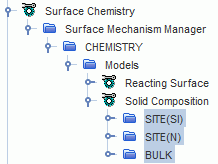Surface Chemistry
In this generalized surface chemistry implementation, the mass fractions of gas or liquid species at the reacting surfaces are assumed to be the same as the mass fractions of gas or liquid species at the center of the cell volume.
As the goal of the surface reaction is to compute concentrations of fluid and site species at the wall, there is the following system of equations to solve:
where is the surface washcoat factor, is the mass fraction of the fluid species at the wall, and is the site species concentration, which is given as:
where is the site density which specifies the number of active sites that exist on the surface. is the surface site fraction which specifies the fraction of the total number of sites that species, , covers. You can set the Surface Initial Site Fraction Profiles at boundaries or interfaces and plot the surface site fractions of each species to monitor these as the reaction proceeds. The sum of all values for all species is equal to one.
Together, Eqn. (3593) and Eqn. (3594) form a system of ODEs that are solved with the CVODE package.
Integrating the Fluid Species Solution Back to Simcenter STAR-CCM+
The solution of this surface reaction model is the composition of the fluid and surface species on the wall, , and . The surface site species fraction is updated directly. For the gas species, the source term of the species transport equation is updated with the addition of averaged source term, :
This term contributes to the region source term from Eqn. (1871).
is the gas-phase or liquid-phase mass fraction at the wall, at the end of the surface chemistry integration, for time-step .
Diffusion-Limited Surface Chemistry in Porous Media
In porous media, where catalytic surfaces are unresolved in the simulation, diffusion of reactants/products to/from the surface can inhibit the surface reaction. This effect is modeled by limiting the surface reaction rate to the lower diffusive flux.
and
- is the density in the gas phase.
- and are the mass transfer coefficients of species and respectively .
- and are the mass fractions of species and respectively.
- is the user-specified porous area per volume. This is the inverse of the mean pore distance .
where is the effective molecular diffusivity of species .
Surface Chemistry with Complex Chemistry
- Species in the gas or liquid phase with mass fractions denoted with
- Species on the surface at the gas-surface or liquid-surface interface with site fractions denoted as . Some sites are “open” (denoted as a generic species ) when they do not contain any species, and they can be used to model absorption from the fluid phase.
- Species in the solid layer—bulk species with their mole fractions denoted as
Limitations to surface chemistry modeling:
- You can only apply surface chemistry to wall and baffle boundaries, interfaces, porous regions, or to porous phases within a fluid region.
- By default, mesh movement is not implemented to account for surface growth or shrinking. However, it is possible to use morphing motion and specify surface site and bulk deposition rates as input using the Surface Chemistry physics model.

It is assumed that the fluid species mass fractions at the reacting surfaces are the same as the fluid species mass fractions at the center of the cell volume. Then species and energy transport equations for the fluid phase have one more source term ( in the species transport equation and in the enthalpy equation) corresponding to surface reactions:
and
It is assumed that no convection or diffusion of surface or bulk species is present. Therefore, the governing transport equations for surface and bulk species are the following:
and
These equations are solved simultaneously.
Output for the fluid phase uses the operator splitting algorithm to transform the fluid species transport equation from the PDE to ODE form. Output for the surface phase consists of the new molar fraction of bulk species and site fraction of surface site species. However, there are two more source terms that are related to the surface-gas or surface-liquid interaction— and in the equations above. Unlike the source terms from the fluid phase, these source terms are not linearized.
The species reaction source Jacobian in Eqn. (3425) and Eqn. (3426) also adds the surface site species in addition to the gas-phase or liquid-phase species.
Operator Splitting Algorithm
This algorithm requires mean values for the source terms over the time-interval .
Index denotes that summation is performed over the gas (or liquid) species. is the partial enthalpy of the fluid species, . Unlike in the case of the fluid phase only, the source terms of species do not sum to 0 so this summation term has to be added to the mass conservation equation.